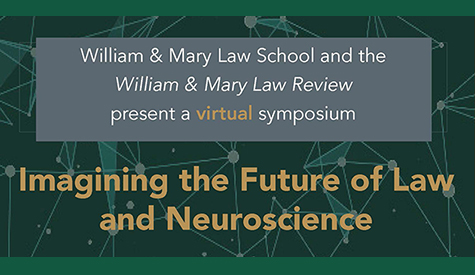William & Mary Law Review Hosts Annual Symposium on the Future of Law and Neuroscience
On February 19 and 20, the William & Mary Law Review hosted its annual Symposium. Entitled “Imagining The Future of Law and Neuroscience,” this year’s virtual environment made it possible for the Law Review to feature scholars from all over the world.
Panelists joined the event from up and down the East Coast, from California, and from as far away as Belgium and the United Kingdom. With more than 300 registrants, this was the Law Review’s best-ever attended symposium, drawing guests from around the globe.
Thirteen leading scholars and professors in law, neuroscience and philosophy were asked to look forward about 10 years and imagine what impact neuroscience could or should have on the law by that time.
Stretching beyond legal questions, the panelists engaged in broad philosophical debates about human nature and societal evolution. For example, panelists challenged attendees to question what kind of criminal punishment, if any, makes sense if human beings do not actually have free will over the actions that our legal system classifies as crimes. The speakers suggested that what we view as intentional human decision making may in fact be driven by neurological impulses shaped by circumstances outside of a person’s control, such as childhood trauma and mental illness. This discussion implicated broad philosophical questions about whether anyone can ever intend to commit a crime.
Applying these theoretical questions to concrete facts, panelists presented and examined data such as convicted individuals’ brain scans and judicial criminal sentencing practices. Ultimately, the symposium prompted lively discussion and debate focused largely on the criminal justice system and whether it effectively serves retributive, deterrent or rehabilitative goals in light of what we now know about how the human brain functions.
To watch the four panels from the symposium, please visit the following links on YouTube:
- Imagining the Future of Law & Neuroscience: Panel 1
- Imagining the Future of Law & Neuroscience: Panel 2
- Imagining the Future of Law & Neuroscience: Panel 3
- Imagining the Future of Law & Neuroscience: Panel 4
The William & Mary Law Review is especially grateful to Professor Peter A. Alces for his work developing the symposium’s topic and inviting panelists to speak at the event. The invaluable hard work of the entire Law Review staff made the smooth logistics and engaging nature of the event possible.
The panelists will publish the research they presented at the Symposium in Volume 63 of the William & Mary Law Review, which will be published in spring 2022.
About William & Mary Law School
Legal education in a university setting began at William & Mary in 1779. Now in its third century, America's first law school continues its historic mission of educating citizen lawyers who are prepared both to lead and to serve.
